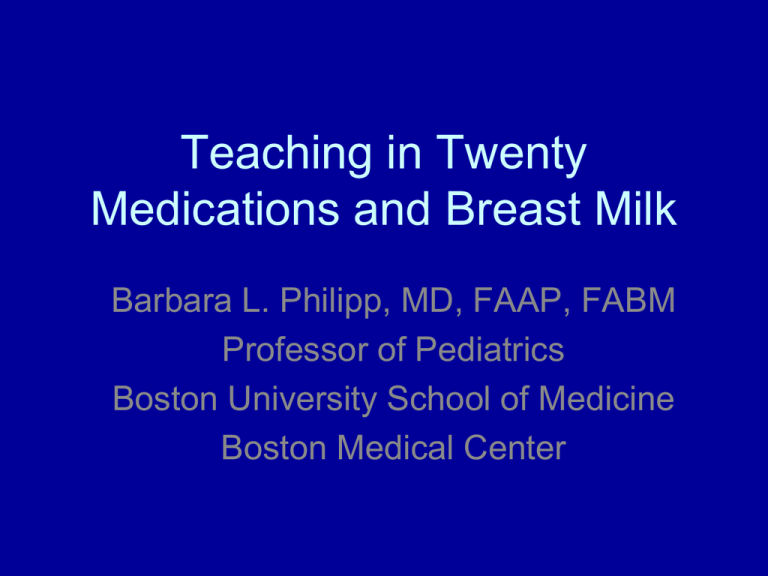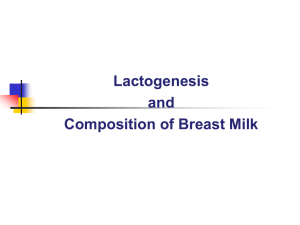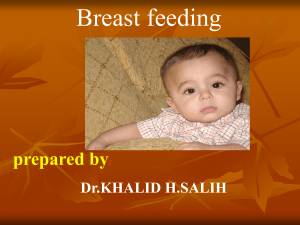Medications and Breastfeeding
advertisement

Teaching in Twenty Medications and Breast Milk Barbara L. Philipp, MD, FAAP, FABM Professor of Pediatrics Boston University School of Medicine Boston Medical Center Objectives: HANDOUT M2 • Name 7 contraindications to breastfeeding • Describe 3 pharmacokinetic factors that influence medications passing from mom to baby via breast milk • List 2 reliable resources for information about medications and breast milk Background - Mothers • 90% of women are prescribed a medication in first week postpartum • Mothers worry about effect of medication on nursing infant • Leads to: non compliance, weaning, avoidance of breastfeeding • 50% of mothers more reluctant to take a medication while nursing than during pregnancy Background – Clinicians • Frequently err erroneously on the side of caution • Slide credit: M Bartick Background – Clinicians • And… • Baby may not comply with “temporary” weaning • Weaning, even temporarily, is traumatic • Need to balance short term med concerns with long term breastfeeding benefits Seven contraindications to breastfeeding (AAP 2005) • • • • • • • Mother HIV + (in USA) Use of illegal drugs by mother Certain medications Active, untreated TB in mother Galactosemia in baby Mother HTLV + Herpes on breast A mother is taking the following medication or drug. She asks you, “Is it to breastfeed?” What is your advice? HANDOUT M1 • • • • • • • • • Cocaine Methadone Glass of wine Heparin Phenytoin (Dilantin) Lithium Magnesium sulfate TMP-SMZ (Bactrim) Tetracycline How to decide if a medication or drug is ok? • Pharmacokinetic factors • Factors which govern drug transfer across membranes into breast milk as well as the metabolism of the drug in mother and infant Pharmacokinetic factors 1. 2. 3. 4. 5. 6. Passive diffusion Molecular weight Protein binding Lipid solubility Half life Oral bioavailability Passive diffusion • Drugs move in and out of breast milk • High to low • With time direction may shift • Example: alcohol Molecular weight • High molecular weight limits movement into breast milk • MW >500 daltons does not enter breast milk Molecular weight: examples • Insulin: MW > 6,000 daltons • Heparin: MW 40,000 daltons • Ethanol: MW 200 Protein binding • Medications circulate in maternal circulation bound or unbound to albumin • Only unbound drug gets into maternal milk • Definition of good protein binding = > 90% Protein binding High protein binding • Propranolol 90% L2 • Diazepam 99% L3 Low protein binding • Lithium 0% L3 Lipid solubility • Drugs that are very lipid soluble penetrate into breast milk in higher concentration • Drugs that are active in the CNS are drugs with high lipid solubility Half life Short half life drugs • Alcohol 24 min • Keflex 50 min • Ibuprofen 120 min • General anesthesia Long half life drugs • Prozac 216 hours Oral bioavailability • Amount of drug that is absorbed from the gut into the blood stream Oral bioavailability Drug Maternal GI Tract Maternal Plasma Breast Milk Infant GI Tract Infant Plasma Oral bioavailability • Low bioavailability may be due to – Reduced absorption in GI tract – Poor GI stability due to acidity – High first-pass uptake by liver Poor oral bioavailability • Gentamycin – <1% oral bioavailability • Insulin (destroyed in gut) – 0% oral bioavailability • Heparin (destroyed in gut) Summary Drugs transfer into human milk if they: • Attain high conc in maternal plasma • Are small enough • Are non-protein bound • Are highly lipid soluble Then once in breast milk: • Are affected by oral bioavailability in baby’s gut In general, baby gets <1% of maternal dose of drug Resources • BAD • Very Very Very Bad • Physician’s Desk Reference (PDR) • Major concern is legal risk Resources • OK • AAP Statement • Committee on Drugs. The transfer of drugs and other chemicals in human milk. Pediatrics 2001;108(3):776-789 Resources THE BEST • Medications and Mothers’ Milk • Thomas Hale, Ph.D. • www.ibreastfeeding.com Medications and Mothers’ Milk Lactation Risk Category • • • • • L1 Safest L2 Safer L3 Moderately safe L4 Possibly hazardous L5 Contraindicated Resources THE BEST • LactMed.com What’s your advice? • Cocaine • No: Hale L5, drug of abuse contraindicated by AAP • Methadone • Yes: Hale L3, (if HIV neg, no illegal drugs) • Alcohol (glass of wine) • Yes: Hale L3, but common sense, moderation, peak levels What’s your advice? • Heparin • Yes: Hale L1 – MW 30,000 daltons, oral bio 0% • • • • • Phenytoin (Dilantin) Yes: Hale L2, AAP ok Lithium Used to be No: Hale L5 Now Yes: Hale L3 with close observation What’s your advice? • • • • • • Magnesium sulfate Yes: Hale L1 TMP-SMZ (Bactrim) Yes: Hale L3, AAP ok Tetracycline Yes: Hale L2, AAP ok – binds to calcium in the milk (<3 weeks use) Take Home Points • Don’t guess • Use Medication and Mothers’ Milk (www.iBreastfeeding.com) • Use LactMed (or toxnet) References • Hale, Thomas. Medications and Mothers’ Milk, 14th ed. Amarillo, TX: Pharmasoft, 2010 – www.ibreastfeeding.com • LactMed on ToxNet – Massbfc.org has link to AAP document and LactMed








